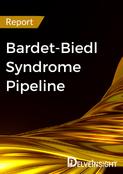bardet biedl syndrome pipeline insight
DelveInsight’s, “Bardet-Biedl Syndrome – Pipeline Insight, 2025,” report provides comprehensive insights about 1+ companies and 1+ pipeline drugs in Bardet-Biedl Syndrome pipeline landscape. It covers the pipeline drug profiles, including clinical and nonclinical stage products. It also covers the therapeutics assessment by product type, stage, route of administration, and molecule type. It further highlights the inactive pipeline products in this space.
Geography Covered
- Global coverage
Bardet-Biedl Syndrome Understanding
Bardet-Biedl Syndrome: Overview
Bardet–Biedl syndrome (BBS) is a rare autosomal recessive ciliopathy. The disease mapped to at least twenty different genes (BBS1-BBS20), follow oligogenic inheritance pattern. BBS proteins localizes to the centerosome and regulates the biogenesis and functions of the cilia. In BBS, the functioning of various systemic organs (with ciliated cells) gets deranged and results in systemic manifestations. The BBS phenotype evolves slowly throughout the first decade of life. As a result, most patients are diagnosed in late childhood or early adulthood.
Symptoms
The symptoms of Bardet-Biedl Syndrome include:
- Truncal obesity
- Intellectual impairment
- Renal anomalies
- Polydactyly
- Retinal degeneration
- Hypogenitalism
Diagnosis
A diagnosis of Bardet-Biedl Syndrome is based upon characteristic findings and clinical findings. Genetic testing may help in confirming the diagnosis for some patients. Multigene panels offer the most effective approach in achieving molecular confirmation of BBS. Unless the diagnosis is suspected based on antenatal imaging revealing polydactyly and structural renal abnormalities, BBS is usually not diagnosed before the patient starts to develop the visual problems characteristic of rod-cone dystrophy.
Treatment
The treatment for BBS patients is focused on the specific signs and symptoms of each individual. Some of the physical abnormalities associated with BBS can be corrected with surgery. Management of obesity may include education, diet, and exercise. The eye problems can be managed with early evaluation by a specialist to provide vision aids and mobility training. Intellectual disability includes early intervention, special education along with speech therapy.
Bardet-Biedl Syndrome Emerging Drugs Chapters
This segment of the Bardet-Biedl Syndrome report encloses its detailed analysis of various drugs in different stages of clinical development, including phase III, II, I, preclinical and Discovery. It also helps to understand clinical trial details, expressive pharmacological action, agreements and collaborations, and the latest news and press releases.
Bardet-Biedl Syndrome Emerging Drugs
- Setmelanotide: Rhythm Pharmaceuticals
Setmelanotide is an investigational, melanocortin-4 receptor (MC4R) agonist in late-stage clinical development. It restores the impaired MC4R pathway function, caused by genetic variants that occur upstream of the receptor. Setmelanotide has the potential to reduce weight and hunger. The U.S. Food and Drug Administration (FDA) has granted Breakthrough Therapy Designation to Setmelanotide for the treatment of Bardet-Biedl syndrome (BBS). Also, the FDA and European Commission has granted Orphan Drug Designation for Setmelanotide for the treatment of BBS.
Further product details are provided in the report……..
Bardet-Biedl Syndrome: Therapeutic Assessment
This segment of the report provides insights about the different Bardet-Biedl Syndrome drugs segregated based on following parameters that define the scope of the report, such as:
- Major Players in Bardet-Biedl Syndrome
There are approx. 1+ key companies which are developing the therapies for Bardet-Biedl Syndrome. The companies which have their Bardet-Biedl Syndrome drug candidates in the most advanced stage, i.e. phase III include, Rhythm Pharmaceuticals.
- Phases
DelveInsight’s report covers around 1+ products under different phases of clinical development like
- Late stage products (Phase III)
- Mid-stage products (Phase II)
- Early-stage product (Phase I) along with the details of
- Pre-clinical and Discovery stage candidates
- Discontinued & Inactive candidates
- Route of Administration
Bardet-Biedl Syndrome pipeline report provides the therapeutic assessment of the pipeline drugs by the Route of Administration. Products have been categorized under various ROAs such as
- Oral
- Parenteral
- intravitreal
- Subretinal
- Topical.
- Molecule Type
Products have been categorized under various Molecule types such as
- Monoclonal Antibody
- Peptides
- Polymer
- Small molecule
- Gene therapy
- Product Type
Drugs have been categorized under various product types like Mono, Combination and Mono/Combination.
Bardet-Biedl Syndrome: Pipeline Development Activities
The report provides insights into different therapeutic candidates in phase II, I, preclinical and discovery stage. It also analyses Bardet-Biedl Syndrome therapeutic drugs key players involved in developing key drugs.
Pipeline Development Activities
The report covers the detailed information of collaborations, acquisition and merger, licensing along with a thorough therapeutic assessment of emerging Bardet-Biedl Syndrome drugs.
Report Highlights
- The companies and academics are working to assess challenges and seek opportunities that could influence Bardet-Biedl Syndrome R&D. The therapies under development are focused on novel approaches to treat/improve Bardet-Biedl Syndrome.
Bardet-Biedl Syndrome Report Insights
- Bardet-Biedl Syndrome Pipeline Analysis
- Therapeutic Assessment
- Unmet Needs
- Impact of Drugs
Bardet-Biedl Syndrome Report Assessment
- Pipeline Product Profiles
- Therapeutic Assessment
- Pipeline Assessment
- Inactive drugs assessment
- Unmet Needs
Key Questions
Current Treatment Scenario and Emerging Therapies:
- How many companies are developing Bardet-Biedl Syndrome drugs?
- How many Bardet-Biedl Syndrome drugs are developed by each company?
- How many emerging drugs are in mid-stage, and late-stage of development for the treatment of Bardet-Biedl Syndrome?
- What are the key collaborations (Industry–Industry, Industry–Academia), Mergers and acquisitions, licensing activities related to the Bardet-Biedl Syndrome therapeutics?
- What are the recent trends, drug types and novel technologies developed to overcome the limitation of existing therapies?
- What are the clinical studies going on for Bardet-Biedl Syndrome and their status?
- What are the key designations that have been granted to the emerging drugs?
Key Players
- Rhythm Pharmaceuticals
Key Products
- Setmelanotide

